Application of Semiconductor Technology for Piezoelectric Energy Harvester Fabrication
Abstract
1. Introduction
- Long and complex manufacturing processing, requiring eight stages, mask fabrication, and application of high temperatures for the thermal oxidation of silicon wafers;
- Form limitations—etching always results in walls inclined at an angle of 54°;
- Wet etching involving chemical reagents that are harmful to humans and the environment;
- Chemical reagents that remain on the structure’s walls as contamination.
2. Materials and Methods
2.1. Design of the PEH Structure
2.2. Fabrication of the Device
2.3. Experimental Setup
3. Experimental Results and Discussion
4. Conclusions
Author Contributions
Funding
Data Availability Statement
Acknowledgments
Conflicts of Interest
References
- Zhou, H.; Zhang, Y.; Qiu, Y.; Wu, H.; Qin, W.; Liao, Y.; Yu, Q.; Cheng, H. Stretchable piezoelectric energy harvesters and self-powered sensors for wearable and implantable devices. Biosens. Bioelectron. 2020, 168, 112569. [Google Scholar] [CrossRef]
- Brusa, E.; Carrera ADelprete, C. A Review of Piezoelectric Energy Harvesting: Materials, Design, and Readout Circuits. Actuators 2023, 12, 457. [Google Scholar] [CrossRef]
- Maamer, B.; Boughamoura, A.; Fath El-Bab, A.M.; Francis, L.A.; Tounsi, F. A review on design improvements and techniques for mechanical energy harvesting using piezoelectric and electromagnetic schemes. Energy Convers. Manag. 2019, 199, 111973. [Google Scholar] [CrossRef]
- Covaci, C.; Gontean, A. Piezoelectric energy harvesting solutions: A review. Sensors 2020, 20, 3512. [Google Scholar] [CrossRef] [PubMed]
- Promphet, N.; Ummartyotin, S.; Ngeontae, W.; Puthongkham, P.; Rodthongkum, N. Non-invasive wearable chemical sensors in real-life applications. Anal. Chim. Acta 2021, 1179, 338643. [Google Scholar] [CrossRef] [PubMed]
- Kamišalić, A.; Fister, I.; Turkanović, M.; Karakatič, S. Sensors and Functionalities of Non-Invasive Wrist-Wearable Devices: A Review. Sensors 2018, 18, 1714. [Google Scholar] [CrossRef]
- Kanno, I. Piezoelectric Pzt Thin Films: Deposition, Evaluation and Their Applications. In Proceedings of the 2019 20th International Conference on Solid-State Sensors, Actuators and Microsystems & Eurosensors XXXIII (TRANSDUCERS & EUROSENSORS XXXIII), Berlin, Germany, 23–27 June 2019; pp. 785–788. [Google Scholar]
- Feenstra, J.; Granstrom, J.; Sodano, H. Energy harvesting through a backpack employing a mechanically amplified piezoelectric stack. Mech. Syst. Signal Process. 2008, 22, 721–734. [Google Scholar] [CrossRef]
- Pawar, O.Y.; Patil, S.L.; Redekar, R.S.; Patil, S.B.; Lim, S.; Tarwal, N.L. Strategic Development of Piezoelectric Nanogenerator and Biomedical Applications. Appl. Sci. 2023, 13, 2891. [Google Scholar] [CrossRef]
- Khan, N.U.; Khan, F.U. Rf energy harvesting for portable biomedical devices. In Proceedings of the 2019 22nd International Multitopic Conference (INMIC), Islamabad, Pakistan, 29–30 November 2019. [Google Scholar] [CrossRef]
- Shabani, E.; Abdekhodaie, S.D.M.J. Laboratory detection methods for the human coronaviruses. Eur. J. Clin. Microbiol. Infect. Dis. 2021, 40, 225–246. [Google Scholar] [CrossRef]
- DeVore, A.D.; Wosik, J.; Hernandez, A.F. The Future of Wearables in Heart Failure Patients. JACC Heart Fail. 2019, 7, 922–932. [Google Scholar] [CrossRef]
- Sunithamani, S.; Lakshmi, P.; Flora, E.E. PZT length optimization of MEMS piezoelectric energy harvester with a non-traditional cross section: Simulation study. Microsyst. Technol. 2013, 20, 2165–2171. [Google Scholar] [CrossRef]
- Amiri, M.H.; Fatscher, R.; Taylor, R.; Rocha, P.R.; Bowen, C.R.; Asadi, K. Piezoelectric energy harvesters: A critical assessment and a standardized reporting of power-producing vibrational harvesters. Nano Energy 2023, 106, 108073. [Google Scholar] [CrossRef]
- Bokla, N.; Klymkovych, T.; Shcherbovskykh, S.; Lisik, Z.; Guzowski, B.; Gozdur, R. The Explosive Boiling as a Chaotic Actuator for Piezoelectric Energy Harvesters. In Proceedings of the 2022 IEEE XVIII International Conference on the Perspective Technologies and Methods in MEMS Design (MEMSTECH), Polyana (Zakarpattya), Ukraine, 7–11 September 2022; pp. 101–104. [Google Scholar] [CrossRef]
- Kim, J.; Byun, S.; Lee, S.; Ryu, J.; Cho, S.; Oh, C.; Kim, H.; No, K.; Ryu, S.; Lee, Y.M.; et al. Cost-effective and strongly integrated fabric-based wearable piezoelectric energy harvester. Nano Energy 2020, 75, 104992. [Google Scholar] [CrossRef]
- Howells, C.A. Piezoelectric energy harvesting. Energy Convers. Manag. 2009, 50, 1847–1850. [Google Scholar] [CrossRef]
- Zhao, J.; You, Z. A shoe-embedded piezoelectric energy harvester for wearable sensors. Sensors 2014, 14, 12497–12510. [Google Scholar] [CrossRef] [PubMed]
- Jung, W.S.; Lee, M.J.; Kang, M.G.; Moon, H.G.; Yoon, S.J.; Baek, S.H.; Kang, C.Y. Powerful curved piezoelectric generator for wearable applications. Nano Energy 2015, 13, 174–181. [Google Scholar] [CrossRef]
- Tao, W. Pendulum-based vibration energy harvesting: Mechanisms, transducer integration, and applications. Energy Convers. Manag. 2023, 276, 116469. [Google Scholar] [CrossRef]
- Sun, R.; Zhou, S.; Cheng, L. Ultra-low frequency vibration energy harvesting: Mechanisms, enhancement techniques, and scaling laws. Energy Convers. Manag. 2023, 276, 116585. [Google Scholar] [CrossRef]
- Rigo, F.; Migliorini, M.; Pozzebon, A. Piezoelectric Sensors as Energy Harvesters for Ultra Low-Power IoT Applications. Sensors 2024, 24, 2587. [Google Scholar] [CrossRef]
- Wang, J.; Zhang, M.; Wang, Z.; Sun, S.; Ning, Y.; Yang, X.; Pang, W. An ultra-low power, small size and high precision indoor localization system based on MEMS ultrasonic transducer chips. IEEE Trans. Ultrason. Ferroelectr. Freq. Control. 2022, 69, 1469–1477. [Google Scholar] [CrossRef]
- Muscalu, G.; Firtat, B.; Anghelescu, A.; Moldovan, C.; Dinulescu, S.; Brasoveanu, C.; Tulbure, A. Piezoelectric MEMS Energy Harvester for Low-Power Applications. Electronics 2024, 13, 2087. [Google Scholar] [CrossRef]
- Kang, M.; Yeo, W.-H. Advances in Energy Harvesting Technologies for Wearable Devices. Micromachines 2024, 15, 884. [Google Scholar] [CrossRef] [PubMed]
- Choi, Y.M.; Lee, M.G.; Jeon, Y. Wearable biomechanical energy harvesting technologies. Energies 2017, 10, 1483. [Google Scholar] [CrossRef]
- Zaia, W.; Gordon, M.P.; Yuan, P.; Urban, J.J. Progress and perspective: Soft thermoelectric materials for wearable and internet-of-things applications. Adv. Electron. Mater. 2019, 5, 1800823. [Google Scholar] [CrossRef]
- Xiao, N.; Yu, W.; Han, X. Wearable heart rate monitoring intelligent sports bracelet based on Internet of things. Measurement 2020, 164, 108102. [Google Scholar] [CrossRef]
- Khan, A.S.; Khan, F.U. A survey of wearable energy harvesting systems. Int. J. Energy Res. 2022, 46, 2277–2329. [Google Scholar] [CrossRef]
- Xia, K.; Zhu, Z.; Zhang, H.; Du, C.; Xu, Z.; Wang, R. Painting a high-output triboelectric nanogenerator on paper for harvesting energy from human body motion. Nano Energy 2018, 50, 571–580. [Google Scholar] [CrossRef]
- Mondal, S.; Paul, T.; Maiti, S.; Das, B.K.; Chattopadhyay, K.K. Human motion interactive mechanical energy harvester based on all inorganic perovskite-PVDF. Nano Energy 2020, 74, 104870. [Google Scholar] [CrossRef]
- Maharjan, P.; Bhatta, T.; Rasel, M.S.; Salauddin, M.; Rahman, M.T.; Park, J.Y. High-performance cycloid inspired wearable electromagnetic energy harvester for scavenging human motion energy. Appl. Energy 2019, 256, 113987. [Google Scholar] [CrossRef]
- Bandodkar, A.J.; You, J.M.; Kim, N.H.; Gu, Y.; Kumar, R.; Mohan, A.V.; Kurniawan, J.; Imani, S.; Nakagawa, T.; Parish, B.; et al. Soft, stretchable, high power density electronic skin-based biofuel cells for scavenging energy from human sweat. Energy Environ. Sci. 2017, 10, 1581–1589. [Google Scholar] [CrossRef]
- Yang, Y.; Pan, H.; Xie, G.; Jiang, Y.; Chen, C.; Su, Y.; Wang, Y.; Tai, H. Flexible piezoelectric pressure sensor based on polydopamine-modified BaTiO3/PVDF composite film for human motion monitoring. Sens. Actuators A Phys. 2020, 301, 111789. [Google Scholar] [CrossRef]
- Khalid, S.; Raouf, I.; Khan, A.; Kim, N.; Kim, H.S. A review of human-powered energy harvesting for smart electronics: Recent progress and challenges. Int. J. Precis. Eng. Manuf. Tech. 2019, 6, 821–851. [Google Scholar] [CrossRef]
- Huang, L.; Lin, S.; Xu, Z.; Zhou, H.; Duan, J.; Hu, B.; Zhou, J. Fiber-based energy conversion devices for human-body energy harvesting. Adv. Mater. 2020, 32, 1902034. [Google Scholar] [CrossRef] [PubMed]
- Fan, K.; Liu, Z.; Liu, H.; Wang, L.; Zhu, Y.; Yu, B. Scavenging energy from human walking through a shoe-mounted piezoelectric harvester. Appl. Phys. Lett. 2017, 110, 143902. [Google Scholar] [CrossRef]
- Zhou, S.; Lallart, M.; Erturk, A. Multistable vibration energy harvesters: Principle, progress, and perspectives. J. Sound Vib. 2022, 528, 116886. [Google Scholar] [CrossRef]
- Khan, F.; Sassani, F.; Stoeber, B. Copper foil-type vibration-based electromagnetic energy harvester. J. Micromech. Microeng. 2010, 20, 125006. [Google Scholar] [CrossRef]
- Khan, F.U.; Qadir, M.U. State-of-the-art in vibration-based electrostatic energy harvesting. J. Micromech. Microeng. 2016, 26, 103001. [Google Scholar] [CrossRef]
- Khan, F.U.; Ali, T. A piezoelectric based energy harvester for simultaneous energy generation and vibration isolation. Int. J. Energy Res. 2019, 43, 5922–5931. [Google Scholar] [CrossRef]
- Yang, Z.; Tang, L.; Tao, K.; Aw, K.C. Modelling and validation of electret-based vibration energy harvesters in view of charge migration. Int. J. Precis. Eng. Manuf. Tech. 2019, 8, 113–123. [Google Scholar] [CrossRef]
- Meng, K.; Zhao, S.; Zhou, Y.; Wu, Y.; Zhang, S.; He, Q.; Wang, X.; Zhou, Z.; Fan, W.; Tan, X.; et al. A wireless textile-based sensor system for self-powered personalized health care. Matter 2020, 2, 896–907. [Google Scholar] [CrossRef]
- Jiang, L.; Yang, Y.; Chen, R.; Lu, G.; Li, R.; Li, D.; Humayun, M.S.; Shung, K.K.; Zhu, J.; Chen, Y.; et al. Flexible piezoelectric ultrasonic energy harvester array for bio-implantable wireless generator. Nano Energy 2019, 56, 216–224. [Google Scholar] [CrossRef] [PubMed]
- Kuang, Y.; Zhu, M. Characterisation of a knee-joint energy harvester powering a wireless communication sensing node. Smart Mater. Struct. 2016, 25, 055013. [Google Scholar] [CrossRef]
- Lakshmi, G.S.; Karumuri, S.R.; Kondavitee, G.S.; Lay-Ekuakille, A. Design and performance analysis of a microbridge and microcantilever-based MEMS pressure sensor for glucose monitoring. IEEE Sens. J. 2023, 23, 4589–4596. [Google Scholar] [CrossRef]
- Xin, Y.; Li, X.; Tian, H.; Guo, C.; Qian, C.; Wang, S.; Wang, C. Shoes-Equipped Piezoelectric Transducer For Energy Harvesting: A Brief Review. Ferroelectrics 2016, 493, 12–24. [Google Scholar] [CrossRef]
- Kiran, R.; Kumar, A.; Sharma, S.; Kumar, R.; Vaish, R. Deciphering the importance of graded poling in piezoelectric materials: A numerical study. Eng. Rep. 2020, 2, e12266. [Google Scholar] [CrossRef]
- Yang, J.; Li, Z.; Xin, X.; Gao, X.; Yuan, X.; Wang, Z.; Zhou, J.; Dong, S. Designing electromechanical metamaterial with full nonzero piezoelectric coefficients. Sci. Adv. 2019, 5, eaax1782. [Google Scholar] [CrossRef] [PubMed]
- Xu, C.; Li, Y.; Yang, T. Optimization of Non-Uniform Deformation on Piezoelectric Circular Diaphragm Energy Harvester with a Ring-Shaped Ceramic Disk. Micromachines 2020, 11, 963. [Google Scholar] [CrossRef]
- Likhon, M.M.; Shawan, S.I.; Alam, M.N.S.B.; Siddique, S. Characterizing Piezoelectric Properties of PZT-4, PZT-5A, PZT-5J, PZT-7A and Lithium Tantalate Material-based Transducers. In Proceedings of the International Conference on Green Energy, Computing and Sustainable Technology, GECOST 2021, Miri, Malaysia, 7–9 July 2021. [Google Scholar]
- Naduvinamani, S.; Iyer, N.C. Design and simulation of PZT based MEMS piezoelectric accelerometer. In Proceedings of the International Conference on Electrical, Electronics, and Optimization Techniques, ICEEOT 2016, Chennai, India, 3–5 March 2016; pp. 3715–3721. [Google Scholar]
- Huang, J.; Yao, M.; Yao, X. A novel approach to improving the electromechanical properties of PZT-based piezoelectric ceramics via a grain coating modification strategy. Ceram. Int. 2021, 47, 16294–16302. [Google Scholar] [CrossRef]
- Mengwei, L.; Tianhong, C.; Weijie, D.; Yan, C.; Jing, W.; Liqun, D.; Liding, W. Piezoelectric microcantilevers with Two PZT thin-film elements for microsensors and microactuators. In Proceedings of the 1st IEEE International Conference on Nano Micro Engineered and Molecular Systems, Zhuhai, China, 18–21 January 2006; pp. 775–778. [Google Scholar]
- Kuang, Y.; Yang, Z.; Zhu, M. Design and characterisation of a piezoelectric knee-joint energy harvester with frequency up-conversion through magnetic plucking. Smart Mater. Struct. 2016, 25, 085029. [Google Scholar] [CrossRef]
- Granstrom, J.; Feenstra, J.; Sodano, H.A.; Farinholt, K. Energy harvesting from a backpack instrumented with piezoelectric shoulderstraps. Smart Mater. Struct. 2007, 16, 1810. [Google Scholar] [CrossRef]
- Shenck, N.S.; Paradiso, J.A. Energy scavenging with shoe-mounted piezoelectrics. IEEE Micro 2001, 21, 30–42. [Google Scholar] [CrossRef]
- Khan, F.; Izhar. Piezoelectric type acoustic energy harvester with a tapered Helmholtz cavity for improved performance. J. Renew. Sustain. Energy 2016, 8, 054701. [Google Scholar] [CrossRef]
- Ferreira, J.C.; Afonso, J.A.; Monteiro, V.; Afonso, J.L. An Energy Management Platform for Public Buildings. Electronics 2018, 7, 294. [Google Scholar] [CrossRef]
- Liu, H.; Fu, H.; Sun, L.; Lee, C.; Yeatman, E.M. Hybrid energy harvesting technology: From materials, structural design, system integration to applications. Renew. Sustain. Energy Rev. 2021, 137, 110473. [Google Scholar] [CrossRef]
- Iqbal, M.; Nauman, M.M.; Khan, F.U.; Abas, P.E.; Cheok, Q.; Iqbal, A.; Aissa, B. Vibration-based piezoelectric, electromagnetic, and hybrid energy harvesters for microsystems applications: A contributed review. Int. J. Energy Res. 2021, 57, 65–102. [Google Scholar] [CrossRef]
- Soupremanien, U.; Ollier, E.; Salamon, N.; Monfray, S.; Skotnicki, T. An experimental device designed to obtain repeatable condensation peaks in a closed system. WIT Trans. Ecol. Environ. 2015, 186, 243–254. [Google Scholar]
- Salamon, N. Development of Thermal Energy Harvesting Systems. NNT: 2018GREAI011. Master’s Thesis, Université Grenoble Alpes/Politechnika, Łódzka, Poland, 2018. (In English). [Google Scholar]
- Li, L.; Chen, Z.; Hao, M.; Wang, S.; Sun, F.; Zhao, Z.; Zhang, T. Moisture-driven power generation for multifunctional flexible sensing systems. Nano Lett. 2019, 19, 5544–5552. [Google Scholar] [CrossRef]
- Rao, J.; Chen, Z.; Zhao, D.; Yin, Y.; Wang, X.; Yi, F. Recent Progress in Self-Powered Skin Sensors. Sensors 2019, 19, 2763. [Google Scholar] [CrossRef]
- Singh, N.; Kumar, A.; Srivastava, K.; Yadav, N.; Singh, R.; Verma, A.S.; Gehlot, A.; Yadav, A.K.; Kumar, T.; Pandey, K.; et al. Challenges and Opportunities in Engineering of Next Generation 3D Microelectronic Devices: Improved Performance, Higher Integration Density. Nanoscale Adv. 2024. [Google Scholar] [CrossRef]
- Rincón-Mora, G.A.; Yang, S. Tiny piezoelectric harvesters: Principles, constraints, and power conversion. IEEE Trans. Circuits Syst. I Regul. Pap. 2016, 63, 639–649. [Google Scholar] [CrossRef]
- Soupremanien, U.; Le Person, S.; Favre-Marinet, M.; Bultel, Y. Influence of the aspect ratio on boiling flows in rectangular mini-channels. Exp. Therm. Fluid Sci. 2011, 35, 797–809. [Google Scholar] [CrossRef]
- Atonge, E.A.; Yang, D. Comparative Evaluation of a Functions for the Soave-Redlich-Kwong Equation of State and the Peng-Robinson Equation of State to Predict Saturation Pressures for Gas(es)-Heavy Oil/Bitumen-Water Systems. SPE Reserv. Eval. Eng. 2023, 26, 1323–1343. [Google Scholar] [CrossRef]
- Groniewsky, A.; Imre, A.R. Prediction of the ORC working fluid’s temperature-entropy saturation boundary using Redlich-Kwong equation of state. Entropy 2018, 20, 93. [Google Scholar] [CrossRef]
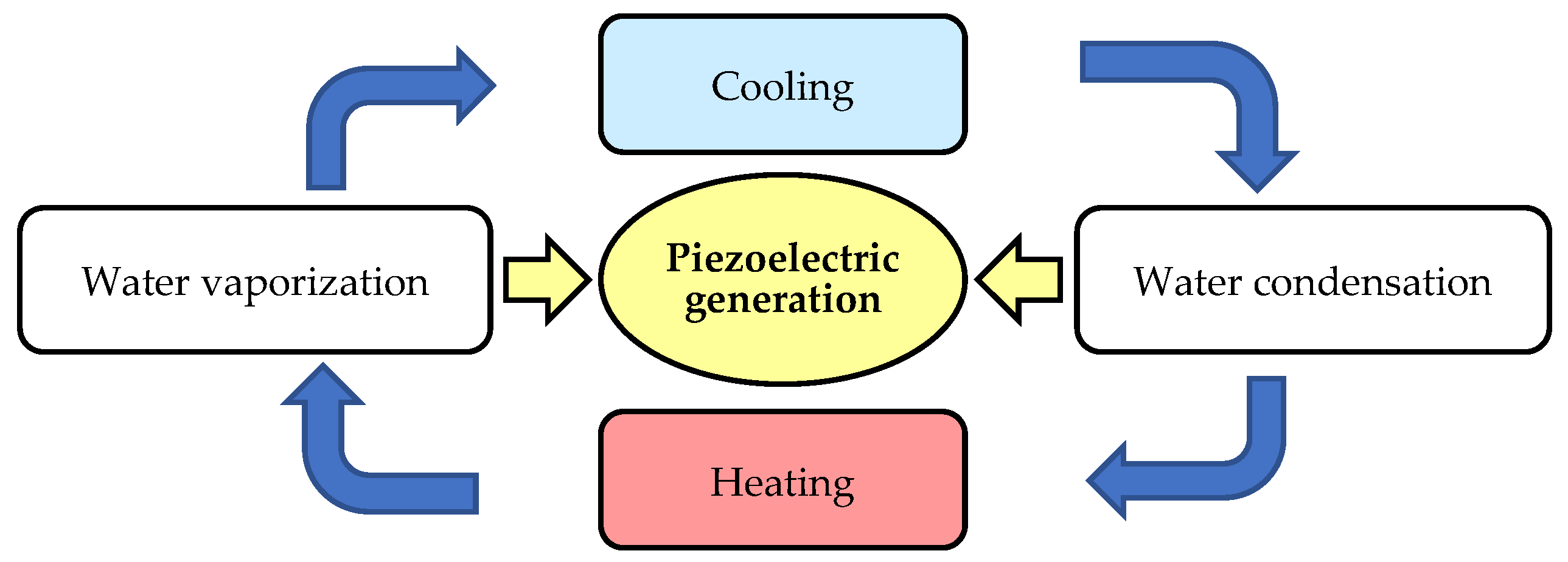

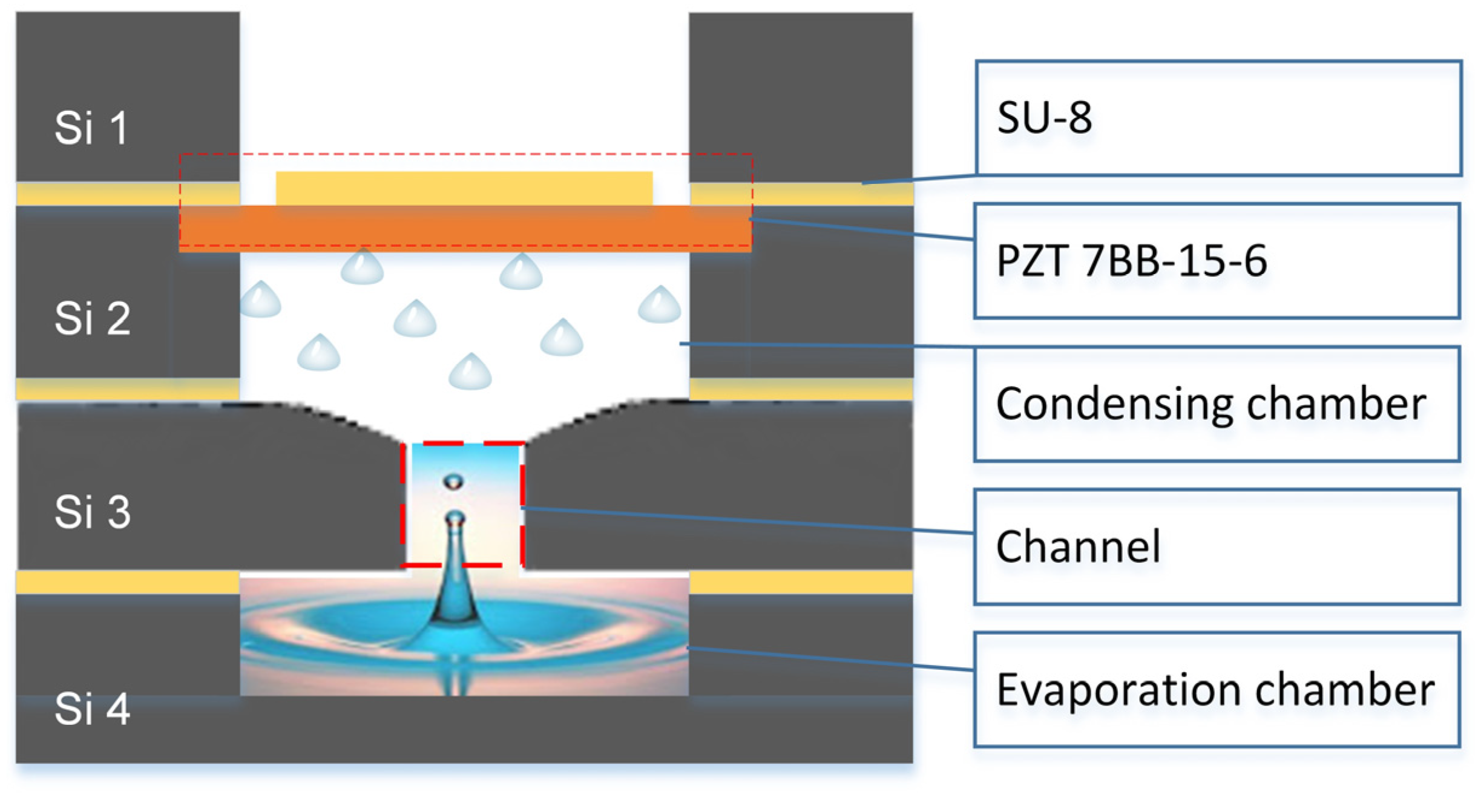

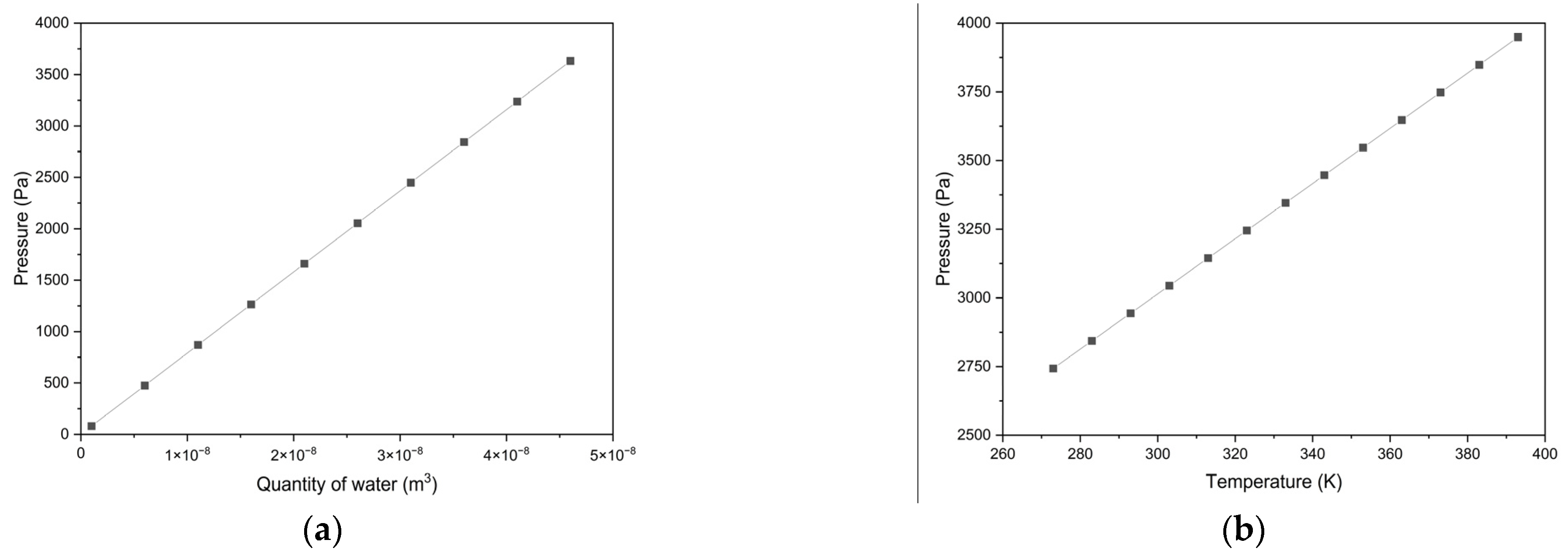

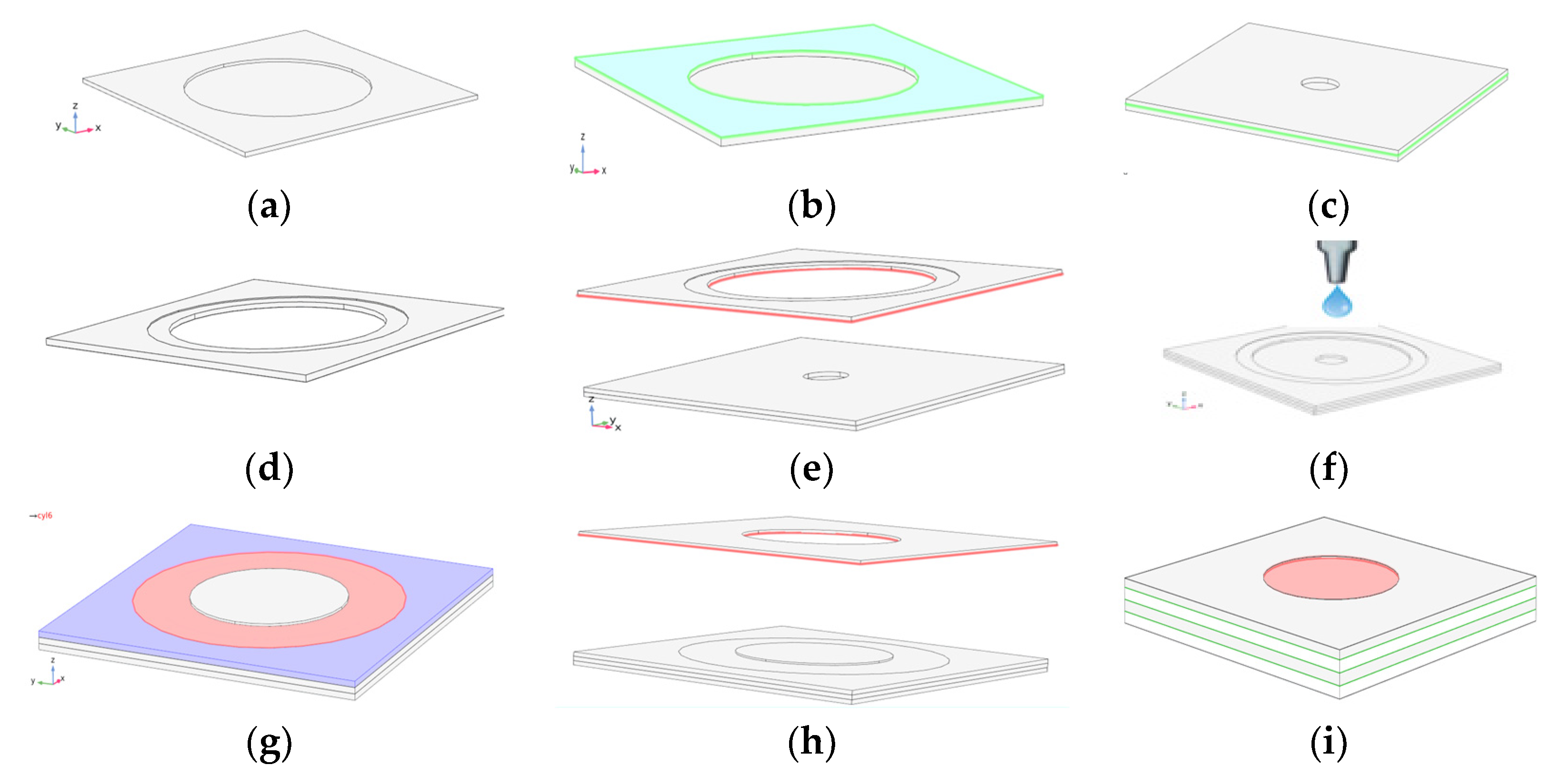
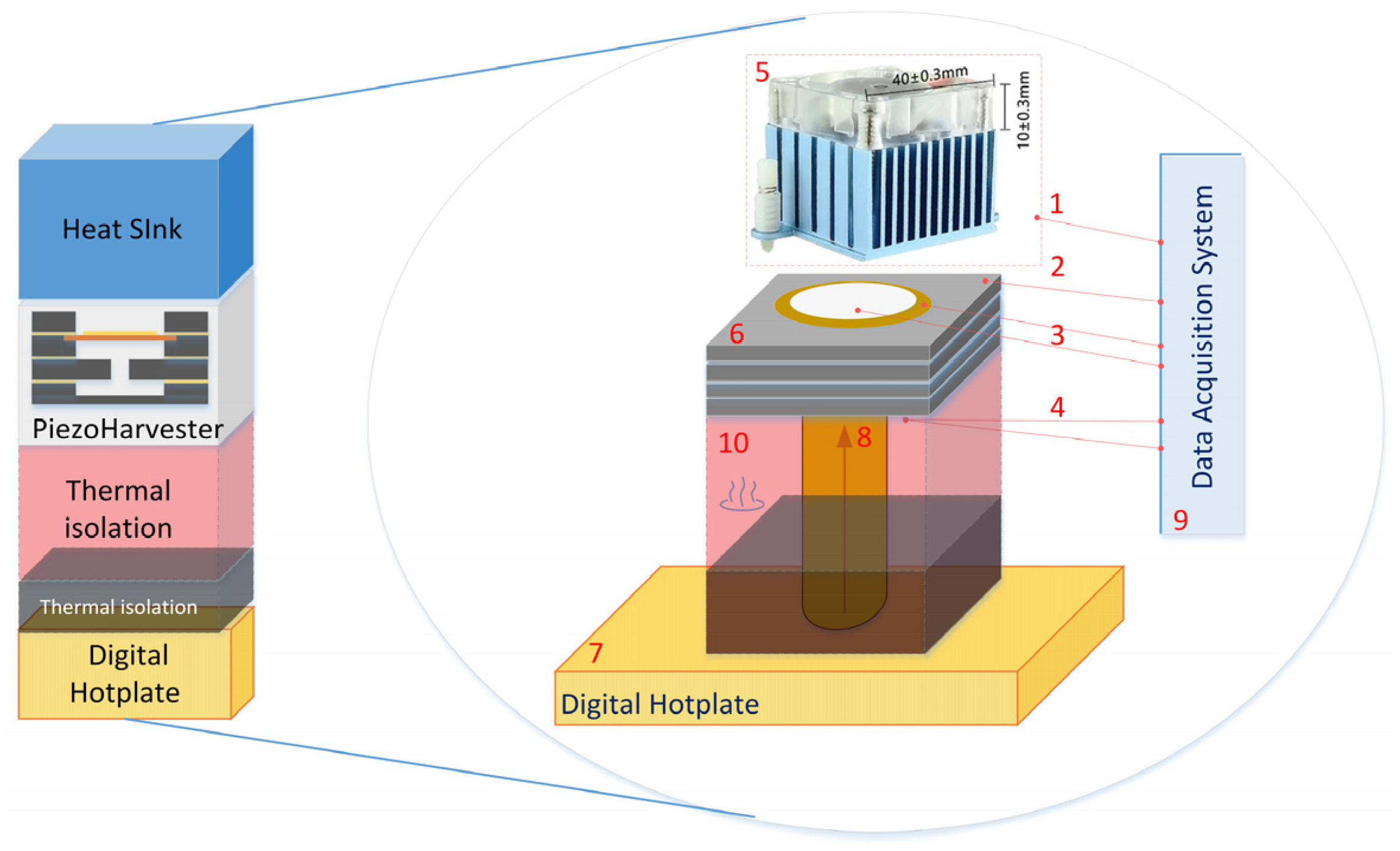


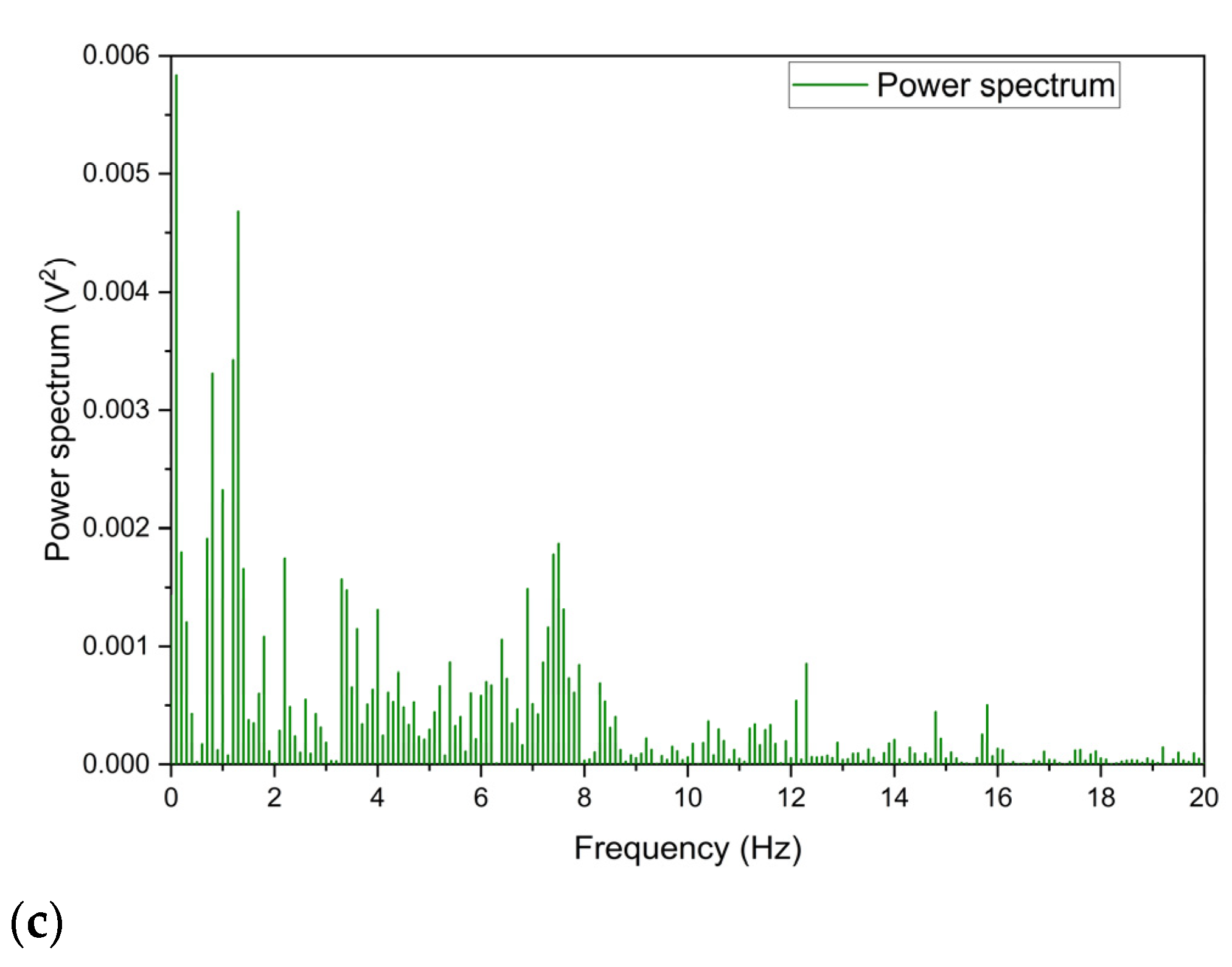

| Type of Piezo Transducer | Pressure [mbar] | ||||||
|---|---|---|---|---|---|---|---|
| 35 | 55 | 75 | 100 | 200 | 300 | 400 | |
| Experimental data [V] | |||||||
| 7BB-15-6 | 3.6 | 6.7 | 8.9 | 11.7 | |||
| Modeled potential [V] | |||||||
| PZT-5J | 1.18 | 1.85 | 2.52 | 3.36 | 6.73 | 10.1 | 13.5 |
| Repetitions = Const. = 40× | |||||
|---|---|---|---|---|---|
| Laser Beam Power [W] | 12 | 14 | 16 | 18 | 20 |
| Depth of silicon machining [µm] | 180.0 | 211.9 | 227.4 | 242.1 | 254.2 |
| Power = const. = 20 W | |||||
| Number of laser beam repetitions | 10 | 20 | 30 | 40 | 50 |
| Depth of silicon machining [µm] | 69.8 | 174.4 | 199.2 | 259.5 | 323.5 |
| Parameter | Waveform Figure 9a, Figure 10a and Figure 11a | Waveform Figure 9b, Figure 10b and Figure 11b | Waveform Figure 9c, Figure 10c and Figure 11c | Remarks |
|---|---|---|---|---|
| Ts, dt, ms | 1 | |||
| T, s | 10,099 | 9703 | 9999 | T = Ts × n |
| fs, Sa/s | 1000 | |||
| n, Samples | 10,099 | 9703 | 9999 | |
| VPeak-peak(t), V | 1.475818 | 1716 | 1089 | Vpp = Vpeak ± Vpeak- |
| VRMS, V | 0.351816 | 0.408 | 0.306 | |
| Vp+/Vp−, V | 1.322512/ −0.15331 | 1.375/−0.341 | 0.966/−0.123 | See Figure 9a–c |
| Avg. RealPower, µW | 0.351816 | 0.408 | 0.306 | |
| Max power, µW | 1.749038 | 1891 | 0.933 | |
| Energy, nJ | 3.552805 | 3959 | 3057 | |
| Frequency of the Max harmonic comp., Vamp, Hz | 0.068 V, 1.26 Hz | 0.076 V, 7.20 Hz | 0.049 V, 1.30 Hz | See Figure 10a–c |
| 2nd higher harmonics, Vamp, Hz | 0.056 V, 7.42 Hz | 0.060 V, 6.79 Hz | 0.002 V, 3.1 Hz | See Figure 10a–c |
| Spectral THD (0.12 Hz–20 Hz), V | 0.521005 | 0.571 | 0.519 | PEH is working not regularly |
Disclaimer/Publisher’s Note: The statements, opinions and data contained in all publications are solely those of the individual author(s) and contributor(s) and not of MDPI and/or the editor(s). MDPI and/or the editor(s) disclaim responsibility for any injury to people or property resulting from any ideas, methods, instructions or products referred to in the content. |
© 2024 by the authors. Licensee MDPI, Basel, Switzerland. This article is an open access article distributed under the terms and conditions of the Creative Commons Attribution (CC BY) license (https://creativecommons.org/licenses/by/4.0/).
Share and Cite
Kubiak, A.; Bokla, N.; Klymkovych, T.; Ruta, Ł.; Bernacki, Ł. Application of Semiconductor Technology for Piezoelectric Energy Harvester Fabrication. Energies 2024, 17, 5896. https://doi.org/10.3390/en17235896
Kubiak A, Bokla N, Klymkovych T, Ruta Ł, Bernacki Ł. Application of Semiconductor Technology for Piezoelectric Energy Harvester Fabrication. Energies. 2024; 17(23):5896. https://doi.org/10.3390/en17235896
Chicago/Turabian StyleKubiak, Andrzej, Nataliia Bokla, Tamara Klymkovych, Łukasz Ruta, and Łukasz Bernacki. 2024. "Application of Semiconductor Technology for Piezoelectric Energy Harvester Fabrication" Energies 17, no. 23: 5896. https://doi.org/10.3390/en17235896
APA StyleKubiak, A., Bokla, N., Klymkovych, T., Ruta, Ł., & Bernacki, Ł. (2024). Application of Semiconductor Technology for Piezoelectric Energy Harvester Fabrication. Energies, 17(23), 5896. https://doi.org/10.3390/en17235896






